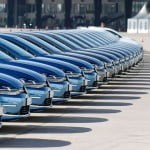For the last several years car manufacturers have been trying to attract car buyers by equipping their new vehicles with a plethora of dazzling innovations such as rear-view cameras, built-in night vision,and global positioning systems.
Judging by per capita new car sales figures, these efforts have largely failed. Americans are far less likely to buy a new automobile than they were just a few decades ago. Population-adjusted car sales in the US have been declining since 1979, and are now a whopping 28% lower than they were almost four decades ago.
The reason for stagnating sales is quite clear: The majority of Americans simply do not have the financial wherewithal to afford new cars.For the last several years citizens have seen job opportunities disappear and wages shrink, while taxes, higher education costs and healthcare insurance premiums and deductibles have skyrocketed.
Worse, Federal Reserve numbers reveal that the US economy is slowing dramatically. The Fed announced that it expects third-quarter GDP growth to be revised down to an anemic 1.0% annual rate. Although the recession ended in 2009, nearly six in ten Americans believe the U.S. is still in a recession or economic downturn, according to recent polls.
According to a report by mega-bank HSBC, global trade is shrinking, down by -8.4 percent year after year, a decline usually found during recessionary periods. While many have been quick to blame the global economic decline for America’s recent economic woes, a strong case can be made that the deteriorating US retail environment is actually exacerbating the global economic decline.
US and global manufacturers are learning that it’s hard to sell cars, or any other item for that matter, in an environment in which over 102 million Americans of working age are not employed and those who do have jobs see their wages and take-home pay shrink.
 America needs a solid strategy for building a prosperous economy that provides Americans well-paying full-time jobs that enable them to acquire new cars and homes. Such policies must include a commitment to reviving American manufacturing and energy sectors and nurturing a regulatory and tax environment that unleashes, not stifles, personal creativity and innovation.
America needs a solid strategy for building a prosperous economy that provides Americans well-paying full-time jobs that enable them to acquire new cars and homes. Such policies must include a commitment to reviving American manufacturing and energy sectors and nurturing a regulatory and tax environment that unleashes, not stifles, personal creativity and innovation.
Car companies hope to boost sales with a new wave of gizmos. “Connected car” technology will soon enable vehicles to exchange information about speed, location, braking, direction of travel, and lane changes. Vehicle-to-infrastructure (V2I) systems will tell the driver when to take a detour to avoid congestion. New apps will alert drivers to ice and other road hazards..
Until the average American’s economic condition improves, he or she will resist the temptation to purchase a new car, regardless of how many attractive technologies and gizmos manufacturers add to these vehicles.
[“source-examiner”]





